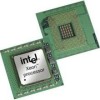Intel BX80605X3430 Data Sheet - Page 12
PCI Express
 |
UPC - 735858210331
View all Intel BX80605X3430 manuals
Add to My Manuals
Save this manual to your list of manuals |
Page 12 highlights
Introduction 1.2.2 System memory features include: • Data burst length of eight for all memory organization modes • 64-bit wide channels • DDR3 I/O Voltage of 1.5 V • Maximum memory bandwidth of 10.6 GB/s in single-channel mode or 21 GB/s in dual-channel mode assuming DDR3 1333 MT/s • 1-Gb and 2-Gb DDR3 DRAM technologies are supported. • Using 2-Gb device technologies, the largest memory capacity possible is 16 GB for UDIMMs (assuming Dual Channel Mode with a four dual rank unbuffered, non-ECC DIMM memory configuration), and 32 GB for RDIMMs (assuming Dual Channel Mode with a four quad-rank registered DIMM memory configuration) • Up to 64 simultaneous open pages, 32 per channel (assuming 8 ranks of 8 bank devices) • Command launch modes of 1n/2n • Intel® Fast Memory Access (Intel® FMA) - Just-in-Time Command Scheduling - Command Overlap - Out-of-Order Scheduling PCI Express* • The processor PCI Express* port(s) are fully-compliant with the PCI Express Base Specification, Revision 2.0. • Intel® Xeon® processor 3400 series with the Intel® 3450 Chipset supports: - One 16-lane PCI Express port intended for graphics attach. - Two 8-lane PCI Express ports for graphics or I/O. • Intel® Xeon® processor 3400 series with the Intel 3420 Chipset supports: - One 16-lane PCI Express port intended for graphics or I/O. - Two 8-lane PCI Express ports intended for I/O. - Four 4-lane PCI Express ports intended for I/O. • Intel® Xeon® processor 3400 series with the Intel 3400 Chipset supports: - Two 8-lane PCI Express ports intended for I/O. - Four 4-lane PCI Express ports intended for I/O. • PCI Express port 0 is mapped to PCI Device 3. • PCI Express port 1 is mapped to PCI Device 5. • The port may negotiate down to narrower widths. - Support for x16/x8/x4/x1 widths for a single PCI Express mode. • 2.5 GT/s and 5.0 GT/s PCI Express frequencies are supported. • Either port can be configured independently as 2.5 GT/s or 5.0 GT/s. • Raw bit-rate on the data pins of 5.0 GB/s, resulting in a real bandwidth per pair of 500 MB/s given the 8b/10b encoding used to transmit data across this interface. This also does not account for packet overhead and link maintenance. • Maximum theoretical bandwidth on interface of 8 GB/s in each direction simultaneously, for an aggregate of 16 GB/s for x16. • Hierarchical PCI-compliant configuration mechanism for downstream devices. • Traditional PCI style traffic (asynchronous snooped, PCI ordering). 12 Datasheet, Volume 1















